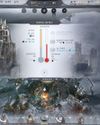
James Wooton at the 2019 Quantum Wheel game jam in Finland.
The Digital Equipment Corporation began producing the PDP-1 in 1959. By 1962, someone had used the million-dollar computer to create a videogame: Spacewar!. It wasn’t the first videogame, but it was the first that could be moved to other computers. And ‘Quantum Tennis For Two’ doesn’t make such a good headline. Spacewar! even comes with an exclamation mark.
The point is, give a scientist millions of dollars’ worth of computing equipment and they will try to use it to play games; and that’s true even today, as IBM researchers developing quantum computers have discovered. Today, you can play Battleships on IBM’s cloud-controlled quantum processor, if you have an account to use it and the right software.
As you might expect, Quantum Battleships differs slightly from the simple hit or miss mechanics of the classic game we’ve all played while on a wet summer holiday in Wales. Noise within the quantum system is interpreted as the effect of weather on the battleships, rolling with the waves and wind and therefore becoming harder to hit. Each battleship is represented by a pair of Qubits, which don’t talk to one another during the game, but nonetheless know each other’s state through quantum entanglement. ‘Bombs’ are a mathematical operation that can affect the degree with which they agree with one another, from which you can work out damage. It’s presented simply, but it’s extremely complex.
QiskitBlocks by James Weaver is an introduction to quantum computing using the open source Minetest engine.
YOU SUNK MY BATTLESHIP
This story is from the {{IssueName}} edition of {{MagazineName}}.
Start your 7-day Magzter GOLD free trial to access thousands of curated premium stories, and 9,000+ magazines and newspapers.
Already a subscriber ? Sign In
This story is from the {{IssueName}} edition of {{MagazineName}}.
Start your 7-day Magzter GOLD free trial to access thousands of curated premium stories, and 9,000+ magazines and newspapers.
Already a subscriber? Sign In

"The War Within itself has kept me coming back most evenings too"
WORLD OF WARCRAFT remains my jailer, and I couldn't be more pleased about it

OK BUILDER
SATISFACTORY is the new titan in building and crafting games

HELL YES
DIABLO IV: VESSEL OF HATRED is a transformative expansion

MOUSE: PI FOR HIRE
This mouse wants to be more than just a gimmick

WINDBLOWN
Dead Cells dev's new roguelike has me afraid for my free time

NO MORE ROOM IN HELL 2
As the zombie horde surrounded me just moments after taking down my two remaining teammates, the writing was really on the wall. Armed with just a chef's knife, it was clear I stood no chance, but I was going down swinging, hoping for a miracle... it didn't come.

OWNED BY STEAM
VALVE cordially reminds you that your games aren't yours

CURSE OF THE AZURE BONDS
These classic games haven't aged badly, but I sure have.

DEEP FREEZE
Endure a blizzard of tough choices and rough consequences in FROSTPUNK 2

NEW HORIZONS
Building up REMNANT 2 outside the live service game grinder